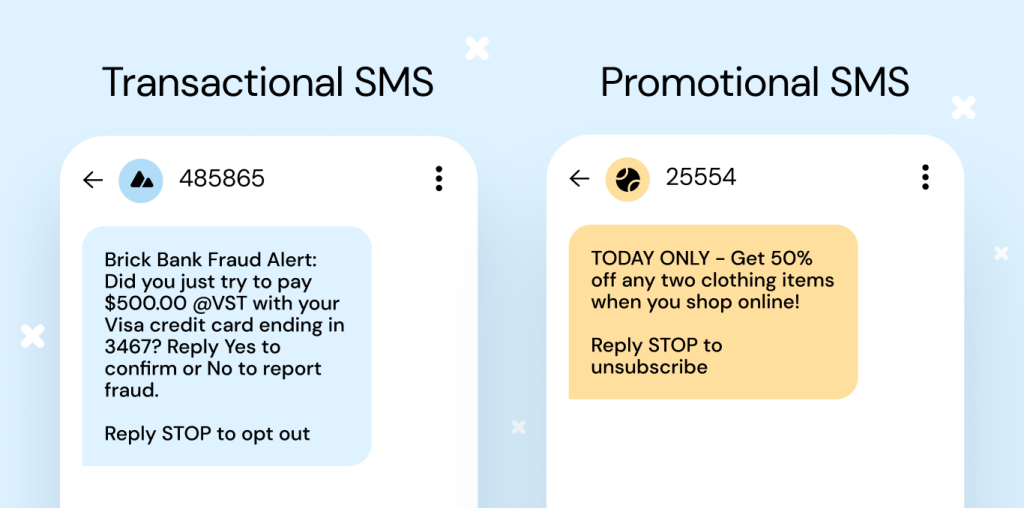Insights
Promotional SMS: Everything you need to know

Insights

Keeping in touch with your customers on a regular basis is the most essential component of prolonging their relationship with your brand. But what’s the best way to do it? Since just about everyone has a phone, SMS marketing stands out as the most effective and direct method of customer communication for short messages.
There are two types of messages that your business can send to boost customer engagement, retention, lifetime value, and more: promotional SMS marketing messages, and transactional SMS messages. Both are important. Both tend to realize sky-high open rates – over 90% is very common. But they serve different purposes, and understanding those differences is key to maximizing their impact.
In this article, you’ll see how promotional text messaging differs from transactional, examples of each, and tips for how to use promotional SMS effectively.
Promotional SMS refers to text messages a business sends out for marketing or advertising purposes. They’re designed to drive engagement, boost sales, and keep your brand top-of-mind. These messages often feature discounts, product launch announcements, and exclusive content.

Brands use promotional SMS to:
It’s a fast, direct way to stay top-of-mind with loyal customers and boost conversion rates.
Pro tip: See real-world examples of promotional SMS in action. Check out our guide to promotional SMS examples for inspiration.
The differences between promotional and transactional SMS messages lie in how you use them. Broadly speaking, promotional SMS is for marketing, while transactional messages deliver essential updates. Knowing the difference ensures compliance and better customer relationships.

Here’s how they compare:
| Feature | Promotional SMS | Transactional SMS |
| Purpose | Supports marketing strategy initiatives (sales, engagement) | Provides essential information (order updates, alerts) |
| Opt-in required? | Required — customers must explicitly opt in to receive them | Recommended to reaffirm your business’ commitment to respecting customer preferences |
| Call to action? | Yes; should encourage a decision or action | Not necessarily; usually purely informational |
| Compliance laws | Strict (Telephone Consumer Protection Act & explicit consent required) | Less restrictive (but still follows TCPA) |
| Examples | Discount code, new product drops, BOGO offers, event invites | Order confirmations, shipping alerts, OTP codes |
Many businesses use both types of SMS to create a seamless customer experience. For example:
While both types of SMS enhance engagement, understanding compliance is crucial. Businesses must follow TCPA regulations, ensuring they collect proper opt-ins for promotional messages and respect customer preferences.
Following proven SMS promotional strategies prevents costly mistakes and frustrated customers. These best practices help you create messages people actually want to read while keeping your business compliant with messaging regulations.
Before sending promotional SMS messages, you must have explicit permission from recipients. Not only is this a legal requirement under the TCPA, but it also ensures you’re reaching an audience that wants to hear from you.
Make it easy — and rewarding — for customers to subscribe. Here are some examples of engaging text opt-in language you can use on different channels:
Pro tip: Make opting in easy and rewarding so your new customers stay engaged. Check out these SMS list growth strategies to increase your subscriber count and make them happy for longer!
Each SMS you sent has a 160-character limit, which includes space for any required opt-out instructions. Every word counts!
Stick to only the most important details like:
If you’re using MMS or Rich SMS, you have more flexibility with visuals and longer text, but keep in mind, customers expect quick, scannable messages in their inbox. The goal? Grab attention, deliver value, and drive action — fast.
Every promotional SMS should tell the recipient exactly what to do next in as few words as possible. A strong call to action (CTA) makes it easy for customers to take immediate steps. Here are some examples:
Keep it short, specific, and action-driven so there’s no confusion about the next step.
Using public URL shorteners (like bit.ly or tinyurl) in promotional SMS can trigger carrier spam filters and reduce message deliverability. Instead, use branded short links that reinforce trust and credibility (e.g., brand.co/deal).
Similarly, avoid using all caps for entire messages. While emphasizing a word or phrase is fine (“Sale ends TONIGHT”), all-caps messages can feel aggressive, spammy, and harder to read.
To ensure higher open rates and engagement, keep formatting natural and use clear, scannable text that feels like a message from a trusted source, not an automated bot.
Urgency drives action. If customers feel they have limited time to act, they’re more likely to engage immediately.
Use time-sensitive language, using aspects like:
Stick to simple, clear deadlines — short SMS messages don’t allow for long explanations. Whether it’s a limited-time offer or a low-stock alert, urgency reduces hesitation and pushes customers to act now, not later.
Your promotional SMS marketing strategy will deliver the best results when integrated with your other marketing channels. Customers engage with brands across email, social media, websites, and apps. SMS should complement these other channels to drive engagement and conversions.
For example:
SMS isn’t a standalone channel — it’s the glue that connects your marketing efforts across email, social, and web for a seamless customer experience. Track key metrics to optimize your omnichannel strategy.
Effective text marketing will get you replies, clicks, and sales – but only with the right approach. These proven text message examples and SMS templates can help a business boost revenue and engagement.
The shortness and the immediacy of SMS marketing make it great for flash sales. You can announce new sales just hours or days away from a deadline via SMS, and it works because most of your subscribers will see it in time to make a decision.
A retail brand might send, “Ends tonight! Get 30% off everything. Shop now: [link].” It’s short, sweet, and gets the offer and point across in less than 100 characters.
These messages work well for clearing inventory or boosting sales during slow periods, as customers are more likely to act fast when they know the offer won’t last.
Limited-time offers create urgency around exclusive deals, making them perfect for seasonal sales, holiday promotions, or customer loyalty program discounts. And SMS is the ideal channel for these time-sensitive promotions because it’s direct, immediate, and reaches customers wherever they are so they don’t miss out.
For example, Vail Resorts used SMS to deliver personalized, time-sensitive offers to skiers. Guests who opted in received real-time updates on weather conditions and exclusive discounts, driving higher engagement and increased purchase rates across 37 resorts in three countries.
When crucial event reminders land in a crowded email inbox, they’re easy to ignore. But SMS can help get the point across with direct, last-minute nudges that can help drive attendance.
Take this example as proof: Family Quest Entertainment used personalized promotional SMS campaigns to reach busy parents and boost event turnout. Sinch’s SMS integration with HubSpot enabled them to send targeted reminders and offers, making it easier for families to plan their weekends.
Watch the video to learn how Family Quest Entertainment sells more tickets and saves time with a personalized promotional SMS strategy.
The result? More engagement, higher ticket sales, and less time spent on event promotions.
Another strong use of promotional SMS or MMS marketing is to shine a light on a single product.
When you pick just one product, you can zoom in on one of its key benefits, a cool way to use it, a positive review, or something else that really grabs your customers’ attention and drives them to make a purchase. It’s all about really focusing on one product to make it irresistible!
As an example, Parfym.se has been using highly targeted SMS marketing to send product promotions to their SMS list subscribers around Blak Friday with great success.
And using Rich SMS, they can integrate the SMS campaign with a landing page, conversational messaging, and other visually engaging content that connects with their customers. The response has been very positive, with open rates over 90%!
Speaking of Black Friday, this event is a prime opportunity for businesses to re-engage customers with exclusive, time-sensitive deals.
Multinational telecommunications giant Orange used Rich SMS and Sinch Campaigns to create a hyper-personalized Black Friday campaign. Based on customer data, they sent tailored offers that drove 12% higher in-store sales and a 78% engagement rate.
A seamless omnichannel strategy keeps customers engaged across multiple touchpoints. Integrating SMS, WhatsApp, and RCS ensures consistent messaging and higher engagement across platforms.
BUT, France’s second-largest home furnishings retailer, rolled out a unified messaging strategy across WhatsApp, RCS, and Rich SMS to reach customers where they preferred to shop. This approach led to a 13.3% click-through rate with RCS, a 123% increase in customers from WhatsApp, and twice the ROI compared to traditional campaigns.
Businesses use transactional SMS to deliver important, time-sensitive updates that keep customers informed. To make sure you’re clear about the differences between promotional SMS, here are a few common use cases and examples of transactional SMS:
Done right, transactional SMS keeps customers engaged and reduces friction at every stage of the journey.
Now that you’ve seen several promotional SMS text examples, got a handle on how to kickstart your promotional SMS marketing strategy, and gotten and understanding about the differences between promotional and transactional text messaging, you’re all set to start putting together your SMS marketing campaign.
But where should you begin? Well, your first move should be picking the right SMS provider. This isn’t a decision you want to have to make every two months, so finding a long-term match is important.
To make it easier, we’ve got a handy, free guide with eight things to consider when choosing your SMS provider. No strings attached!
Ready to make the move to a powerful SMS sending platform? Check out Sinch Engage, your one-stop shop to deliver messages that get attention and results.
Or, if you’re looking for the right SMS API provider to solve your complex sending needs, schedule a time to chat with us. Our team is always around to talk about how to make the most out of your SMS campaigns.